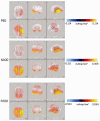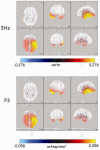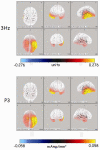Cortical evoked potentials to an auditory illusion: binaural beats
- PMID: 19616993
- PMCID: PMC2741401
- DOI: 10.1016/j.clinph.2009.06.014
Cortical evoked potentials to an auditory illusion: binaural beats
Abstract
Objective: To define brain activity corresponding to an auditory illusion of 3 and 6Hz binaural beats in 250Hz or 1000Hz base frequencies, and compare it to the sound onset response.
Methods: Event-Related Potentials (ERPs) were recorded in response to unmodulated tones of 250 or 1000Hz to one ear and 3 or 6Hz higher to the other, creating an illusion of amplitude modulations (beats) of 3Hz and 6Hz, in base frequencies of 250Hz and 1000Hz. Tones were 2000ms in duration and presented with approximately 1s intervals. Latency, amplitude and source current density estimates of ERP components to tone onset and subsequent beats-evoked oscillations were determined and compared across beat frequencies with both base frequencies.
Results: All stimuli evoked tone-onset P(50), N(100) and P(200) components followed by oscillations corresponding to the beat frequency, and a subsequent tone-offset complex. Beats-evoked oscillations were higher in amplitude with the low base frequency and to the low beat frequency. Sources of the beats-evoked oscillations across all stimulus conditions located mostly to left lateral and inferior temporal lobe areas in all stimulus conditions. Onset-evoked components were not different across stimulus conditions; P(50) had significantly different sources than the beats-evoked oscillations; and N(100) and P(200) sources located to the same temporal lobe regions as beats-evoked oscillations, but were bilateral and also included frontal and parietal contributions.
Conclusions: Neural activity with slightly different volley frequencies from left and right ear converges and interacts in the central auditory brainstem pathways to generate beats of neural activity to modulate activities in the left temporal lobe, giving rise to the illusion of binaural beats. Cortical potentials recorded to binaural beats are distinct from onset responses.
Significance: Brain activity corresponding to an auditory illusion of low frequency beats can be recorded from the scalp.
Figures






Similar articles
-
A comparison of auditory evoked potentials to acoustic beats and to binaural beats.Hear Res. 2010 Apr;262(1-2):34-44. doi: 10.1016/j.heares.2010.01.013. Epub 2010 Feb 1. Hear Res. 2010. PMID: 20123120
-
Human auditory steady state responses to binaural and monaural beats.Clin Neurophysiol. 2005 Mar;116(3):658-68. doi: 10.1016/j.clinph.2004.09.014. Clin Neurophysiol. 2005. PMID: 15721080
-
Auditory evoked responses to binaural beat illusion: stimulus generation and the derivation of the Binaural Interaction Component (BIC).Annu Int Conf IEEE Eng Med Biol Soc. 2011;2011:830-3. doi: 10.1109/IEMBS.2011.6090190. Annu Int Conf IEEE Eng Med Biol Soc. 2011. PMID: 22254439
-
Absence of both auditory evoked potentials and auditory percepts dependent on timing cues.Brain. 1991 Jun;114 ( Pt 3):1157-80. doi: 10.1093/brain/114.3.1157. Brain. 1991. PMID: 2065245 Review.
-
Experimental-neuromodeling framework for understanding auditory object processing: integrating data across multiple scales.J Physiol Paris. 2006 Jul-Sep;100(1-3):133-41. doi: 10.1016/j.jphysparis.2006.09.006. Epub 2006 Oct 31. J Physiol Paris. 2006. PMID: 17079121 Free PMC article. Review.
Cited by
-
Spectral-power associations reflect amplitude modulation and within-frequency interactions on the sub-second timescale and cross-frequency interactions on the seconds timescale.PLoS One. 2020 May 18;15(5):e0228365. doi: 10.1371/journal.pone.0228365. eCollection 2020. PLoS One. 2020. PMID: 32421714 Free PMC article.
-
Understanding the neurological mechanism involved in enhanced memory recall task following binaural beat: a pilot study.Exp Brain Res. 2021 Sep;239(9):2741-2754. doi: 10.1007/s00221-021-06132-6. Epub 2021 Jul 7. Exp Brain Res. 2021. PMID: 34232346 Free PMC article.
-
Event-related potentials to single-cycle binaural beats and diotic amplitude modulation of a tone.Exp Brain Res. 2019 Aug;237(8):1931-1945. doi: 10.1007/s00221-019-05562-7. Epub 2019 May 20. Exp Brain Res. 2019. PMID: 31111175
-
A Review of Binaural Bates and the Brain.Basic Clin Neurosci. 2024 Mar-Apr;15(2):133-146. doi: 10.32598/bcn.2022.1406.2. Epub 2024 Mar 1. Basic Clin Neurosci. 2024. PMID: 39228447 Free PMC article. Review.
-
Neural representation of scale illusion: magnetoencephalographic study on the auditory illusion induced by distinctive tone sequences in the two ears.PLoS One. 2013 Sep 23;8(9):e75990. doi: 10.1371/journal.pone.0075990. eCollection 2013. PLoS One. 2013. PMID: 24086676 Free PMC article.
References
-
- Attias J, Urbach D, Gold S, Shemesh Z. Auditory event related potentials in chronic tinnitus patients with noise induced hearing loss. Hear. Res. 1993;71:106–113. - PubMed
-
- Barr DF, Mullin TA, Herbert PS. Application of binaural beat phenomenon with aphasic patients. Arch Otolaryngol. 1977;103:192–194. - PubMed
-
- Draganova R, Ross B, Wollbrink A, Pantev C. Cortical steady-state responses to central and peripheral auditory beats. Cereb Cortex. 2008;18:1193–11200. - PubMed
-
- Fritze W. On binaural beats. Arch Otorhinolaryngol. 1985;242:301–303. - PubMed
Publication types
MeSH terms
Grants and funding
LinkOut - more resources
Full Text Sources
Other Literature Sources
Research Materials

